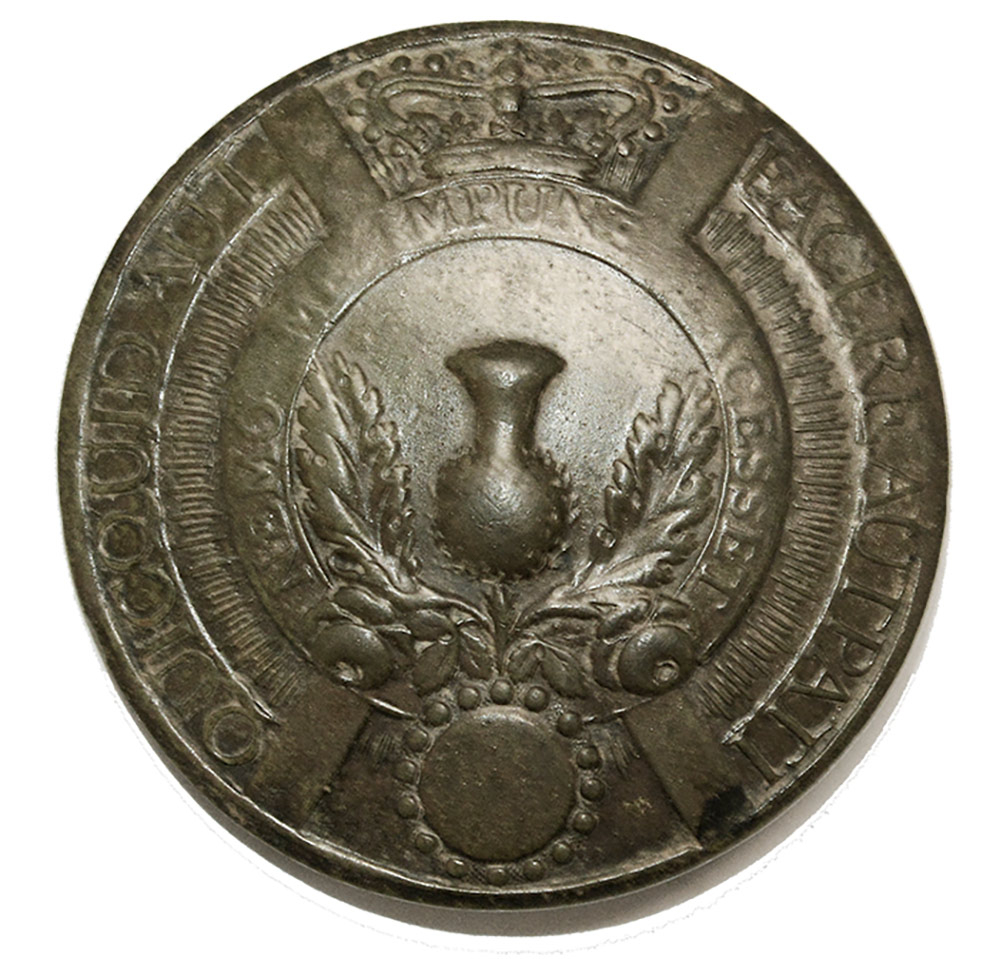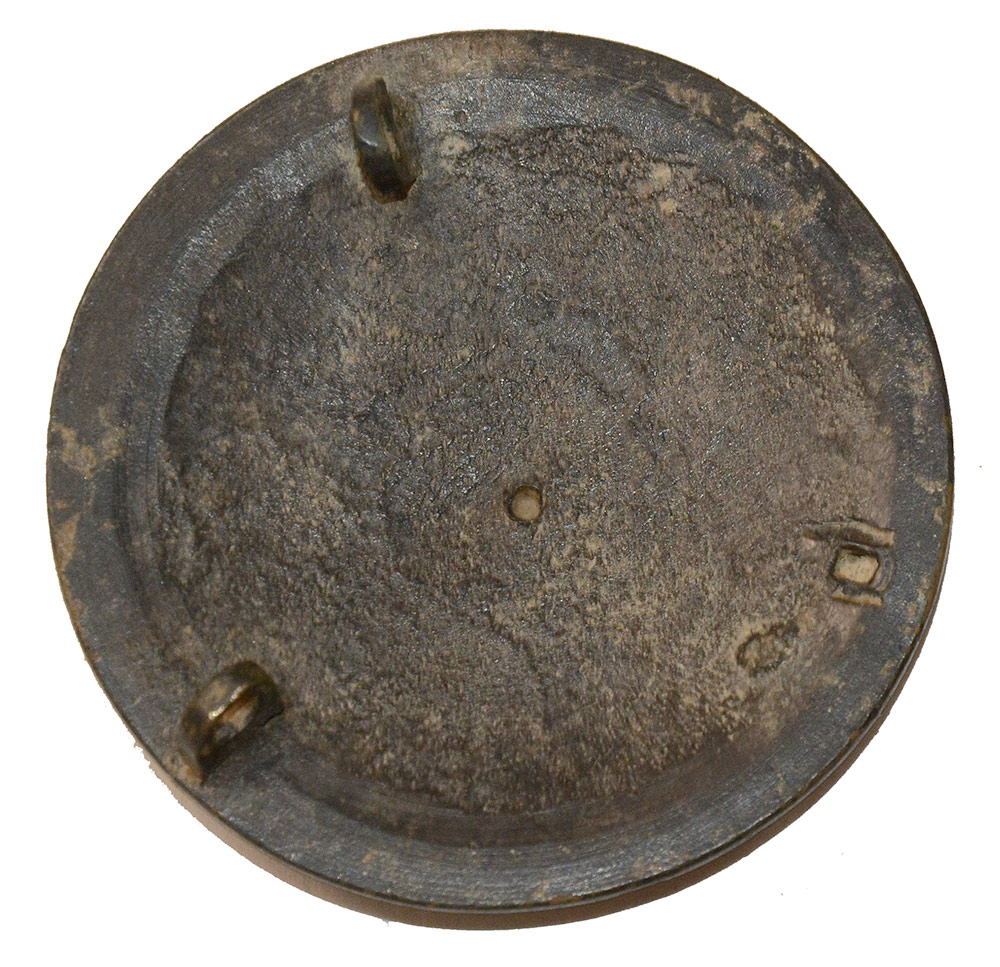site search
online catalog
VERY RARE REVOLUTIONARY WAR 84th REGIMENT, ROYAL HIGHLAND EMIGRANTS, CARTRIDGE BOX PLATE, ONE OF FIVE KNOWN

Hover to zoom


$5,950.00 SOLD
Quantity Available: None
Item Code: 844-32
This is one of five known examples of the rare cartridge box plate worn by the Royal Highland Emigrants, the 84th Regiment of Foot, in the Revolutionary War. These are identical to the plates worn by the 71st Regiment and were certainly produced by the same maker, but lack a regimental numerical designation in the rondel at the bottom of the face, indicating they were contracted for prior to the regiment’s designation as the 84th in January 1779. They are identified to the 84th not only by find locations, but more recently by a non-excavated silvered copper repousse example, likely for a sergeant, retained by descendants of a member of the 84th along with other artifacts.
This comes from Fort Haldimand, more generally Carleton Island, formerly known as Deer Island, in the St. Lawrence River. The site was occupied by elements of the regiment’s First Battalion and was a staging point for the transhipment of supplies and for British operations, particularly in the Mohawk Valley, and along the St. Lawrence, and on Lake Ontario. It is also well known for the wonderful condition of many artifacts excavated in the area. This plate is missing any gilt wash, but retains sharp detail on the face and two out of three small pierced retaining lugs on the reverse, the missing one explaining its loss. The pierced, flat lugs, sweated into small recesses on the reverse of the plate and intended to retain the plate by a cord or thong, are identical to those used on the contemporary plates of the 71st, which had originally used simple pins that proved inadequate to the task of holding the plate on or permitting its easy removal for cleaning.
The plate is round, cast brass, showing on the face a crown at top center, thistle in the middle, with the motto in raised letters, “QUICQUID AUT FACERE AUT PATI (“Whatever (is necessary) to do or endure”) in an outer band, and “NEMO ME IMPUNE LACESSET” (“No one wounds me with impunity”) in smaller letters in an inner band, the two bands separated by serrated bands at either side. The raised rondel with dotted border appears at bottom between the legs of a St. Andrew’s Cross. It has a beautiful, even gold-green patina best described as a dark chartreuse, a little darker in the recess between the feet of the cross and only one small dark spot on the right foot of the cross. There is some very light rubbing just at the upper left and upper right of the inner band and motto, high points most subject to wear, softening just slightly the “ME I” of “me impune” and the “E LACE” of “impune lacessit,” but with the letters fully visible and legible. The reverse shows the characteristic smooth outer edge where the casting sprue was removed as part of the finishing process and three notches made for the placement of the lugs. The plate was certainly gilt when issued, the regimental metal being gold, though there is evidence that sergeants and officers made use of silver as well.
The idea for the regiment originated in late 1774, purportedly part of a plan for Scottish emigrants to receive land in exchange for a promise to bear arms for the crown in the event of trouble. In the event, the regiment was finally authorized by General Gage in June 1775, in the wake of Lexington and Concord. Officially named the Royal Highland Emigrants and under the command of Lt. Col. Allan McLean, the regiment was sometimes known as the “Young Emigrants” after a similar unit, recruited by Major John Small, was amalgamated with it. Although anticipated as perhaps five battalions strong, it remained at two battalions of ten companies each, the First Battalion commanded by McLean and the Second by Small.
They expected to draw recruits from veterans of highland regiments who had remained in America after discharge at the end of the French and Indian War, particularly former members of the 42nd, 71st, and 72nd Regiments. Once commissioned, officers sought recruits not only in Canada, but New England, New York City and the Mohawk Valley, and as far south as North Carolina. Others were fresh off emigrant ships, and there were also recruits from American prisoners of war and deserters. The regiment was to be equipped and clothed in highland dress like the The Black Watch (the 42nd Regiment,) and wore kilts, sporran, blue-trimmed red jackets, and bonnets, but until late 1776 was uniformed by necessity like more conventional loyalist forces.
Some of the regiment’s officers fought at Bunker Hill, but the unit’s baptism of fire took place at Quebec in the winter of 1775/76 when it played a crucial part in defeating the attempt by Montgomery and Arnold to take the city. Other parts of the regiment saw action a short time later in North Carolina, where they were in the Battle of Moore’s Creek Bridge. In the end, the First Battalion served mainly in Quebec, Ontario, Northern New York, and Michigan, while the Second serving even more broadly and scattered, with detachments in the Atlantic provinces fighting American privateers and raiding parties, serving in New York City and environs, and in the southern theatre of war, in Virginia, South Carolina and Georgia, seeing action at Charleston, Ninety-Six, Eutaw Springs, and elsewhere.
The First Battalion in the meantime saw additional service in forts along the St. Lawrence River, the Richelieu River, the shores of Lake Ontario and Lake Erie, in northern New York in the Lake Champlain area, and as far west as Michigan. Postings included Quebec City, Carleton Island (the site of Fort Haldimand, where this plate was recovered,) St. Helen’s Island, Montreal, Sorrel, Ft. St. Johns, Ft. Chambly, Trois Rivieres, La Chenage, Terrebonne, Riviere du Chene, Isle aux Noix, Ft. Ticonderoga, Ft. Edward, and Niagara. The regiment as a whole served until discharge in detachments in 1783 and 1784, with many of the veterans settling on military land grants in Canada.
This plate is identical to Plate B84PL4 in Troiani and Kochan, Insignia of Independence, also recovered at Fort Haldimand. They were likely worn on the cartridge box carried around the waist, the “belly box.” The size misled some early students to think them a bonnet badge. All in all, this is a superior example of a very, very scarce Revolutionary War plate from an active highland regiment. [sr] [ph:L]
~~~~~~~~~~~~~~~~~~~~~~~~~~~~~~~~~~~
THIS ITEM, AS WITH ALL OTHER ITEMS AVAILABLE ON OUR WEB SITE,
MAY BE PURCHASED THROUGH OUR LAYAWAY PROGRAM.
CLICK HERE FOR OUR POLICIES AND TERMS.
THANK YOU!
Inquire About VERY RARE REVOLUTIONARY WAR 84th REGIMENT, ROYAL HIGHLAND EMIGRANTS, CARTRIDGE BOX PLATE, ONE OF FIVE KNOWN
Most Popular
Historical Firearms Stolen From The National Civil War Museum In Harrisburg, Pa »
Theft From Gravesite Of Gen. John Reynolds »
Selection Of Unframed Prints By Don Troiani »
Fine Condition Brass Infantry Bugle Insignia »
featured item
VERY SCARCE 1799-1800 SWAN CONTRACT VIRGINIA MILITIA REGIMENTALLY MARKED MUSKET: 42nd REGIMENT, PITTSYLVANIA
This musket is stamped “42. VA. REGT. PITTSYLVANIA” on the barrel, was later altered to percussion and then shortened for use in the civilian market. It is a scarce survivor from muskets delivered to Virginia by Jame Swan of Boston in January… (1000-241). Learn More »


